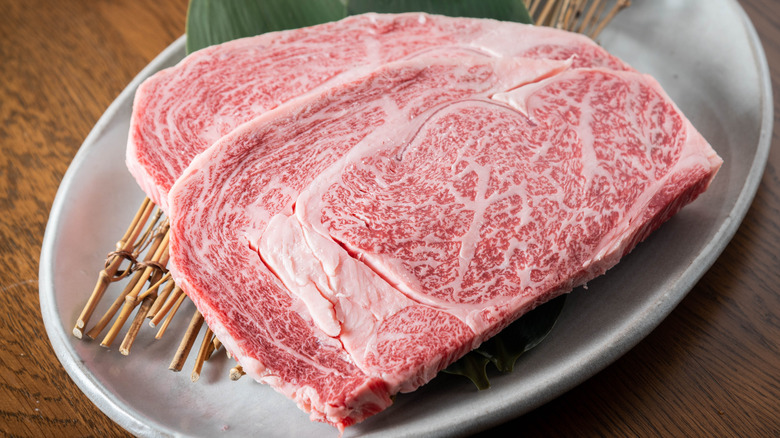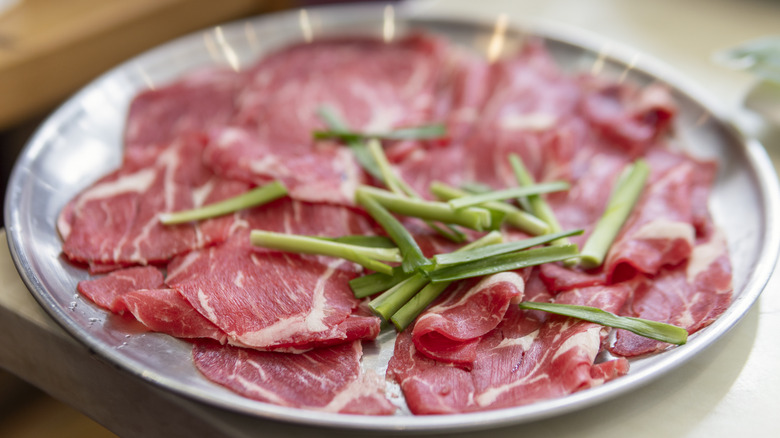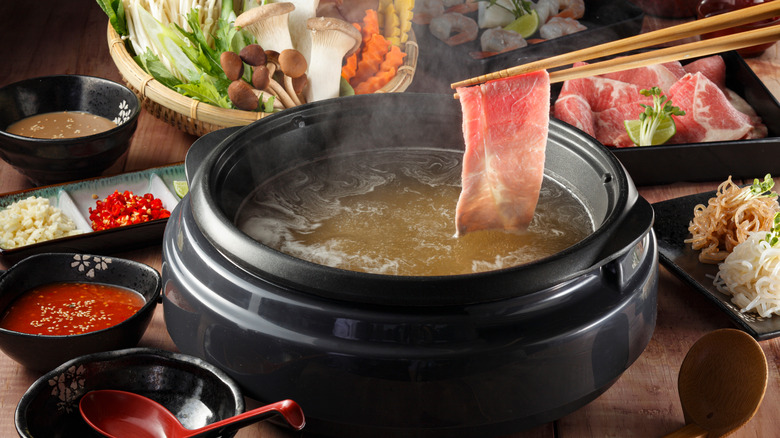Sorry, But Wagyu And Kobe Beef Are Not The Same Thing
A good cut of fatty beef melts in your mouth and is tender to the bite, perfect for serving with vegetables or over rice. And if you're a steak fan you likely know there is a beloved cattle breed that produces uniquely rich and marbled meat: Wagyu. Kobe beef is another prized marbled beef from Japan, and at times you'll see Wagyu and Kobe beef used interchangeably on menus. However, this is not correct in most cases, since the two types of beef (though similar) are different — and the distinction comes down to region.
Wagyu is used to describe multiple types of Japanese cattle and can include different strains and breeds from across the country. Kobe beef is simply a type of Wagyu, with specific breeding, marbling, and quality requirements that are unique to the region of Kobe city in Hyōgo prefecture.
In winemaking, 'terroir' describes the effect regional environment and traditions have on the grapes (and thus the wine) made there. This phenomenon also plays out in cattle breeding standards. All Wagyu is known for fatty striations throughout the cut of meat, but the specific strain and breed of Japanese cattle the beef comes from results in different beef flavors among the various regions. Compared to Wagyu, which has a range of flavors including nutty and subtly sweet depending on the cattle breed, Kobe beef is characteristically known (and coveted) for its buttery flavor and mouthfeel, which makes its taste delightfully rich when sliced thin and seared to medium or rare.
Kobe is a specific (and rare) beef
If you see Wagyu beef listed on a menu, it could be meat from various Japanese cattle, including Japanese Black, Brown, or Shorthorn cows. In the states, there also are American styles of Wagyu, in which Wagyu cattle are bred with American cattle types, like Angus. This results in desirably marbled beef, but the taste and texture will likely be a departure from the traditional and highly selective cuts of purebred cattle from regions like Kobe.
Kobe beef comes from relatively young cows of the Japanese Black cattle strain called Tajima, which have been born, raised, and slaughtered in the Kobe region. And there are very specific regulations around the meat — including using select bulls with a clearly documented lineage for breeding. This high emphasis on cattle specificity makes Kobe beef rare, expensive, and prized.
All Wagyu beef is known for its rich, evenly distributed marbling that is pretty much melded into the meat (so much so that the meat has thin, interwoven fat striations throughout and often looks pink from the fat distribution). However, Kobe has additional marbling requirements and needs to score at least six on the Japanese Beef Marbling Score system, which Steaks and Game explains runs from three to 12. Other types of Wagyu from Japanese cattle, including Ohmi and Matsusaka beef from other regions, are extremely delicious in their own regard — the taste and texture profiles will just be different.
How to enjoy Wagyu and Kobe beef
In all honesty (and due to its rarity), the best way to experience the luxurious quality of Kobe is to travel to Japan, where the beef is enjoyed in small quantities at each sitting because it's such a rich cut of meat. There, it's commonly enjoyed simply — seared to medium or rare and with just a bit of salt and pepper. To highlight the rich, buttery flavor of Kobe beef, there's no need to over-season it. It can also be cooked in Japanese hot pot (aka shabu-shabu), eaten with other thin cuts of veggies, or barbecued.
Both Wagyu and Kobe beef are pricey, but Kobe comes in at a higher price due to its comparative specificity and unique specifications. In the States, you likely won't find Kobe in your local grocery store, but you may be able to find a quality meat distributor where you get tasty cuts of the beef. Since American Wagyu is common, you're more likely to see Wagyu beef listed on menus. However, a true Wagyu or Kobe cut is rich with its fatty marbling, so it likely won't be featured in large quantities or steaks.
However, you may still see many steakhouses with Kobe or Wagyu listed on menus interchangeably. Be wary of chain steakhouses or restaurants that list Kobe beef on their menus, as there have been cases of mislabeling and even up-charging meats, according to a report from Inside Edition, inaccurately listing your standard cuts of steak as beloved Kobe beef.


